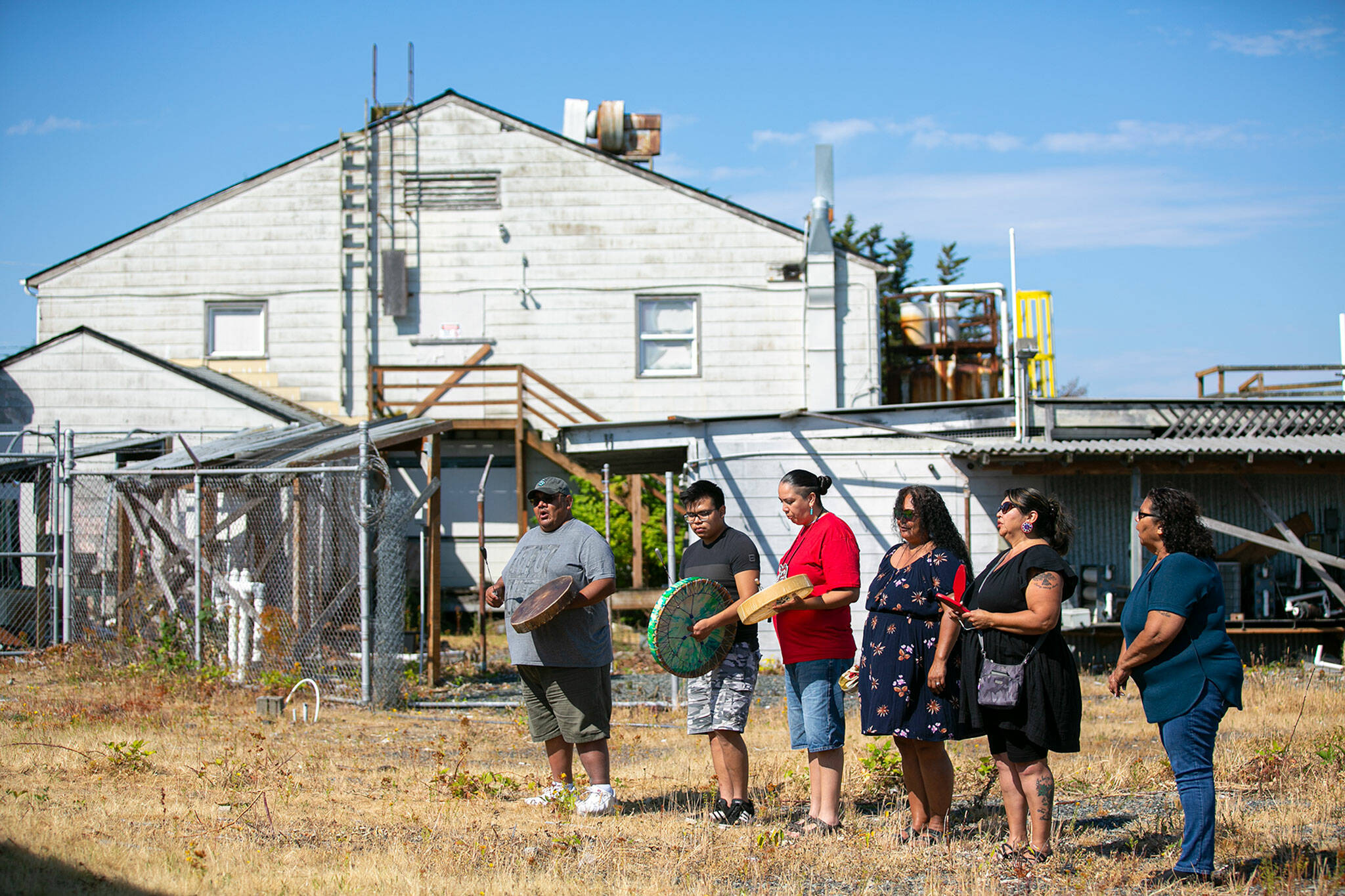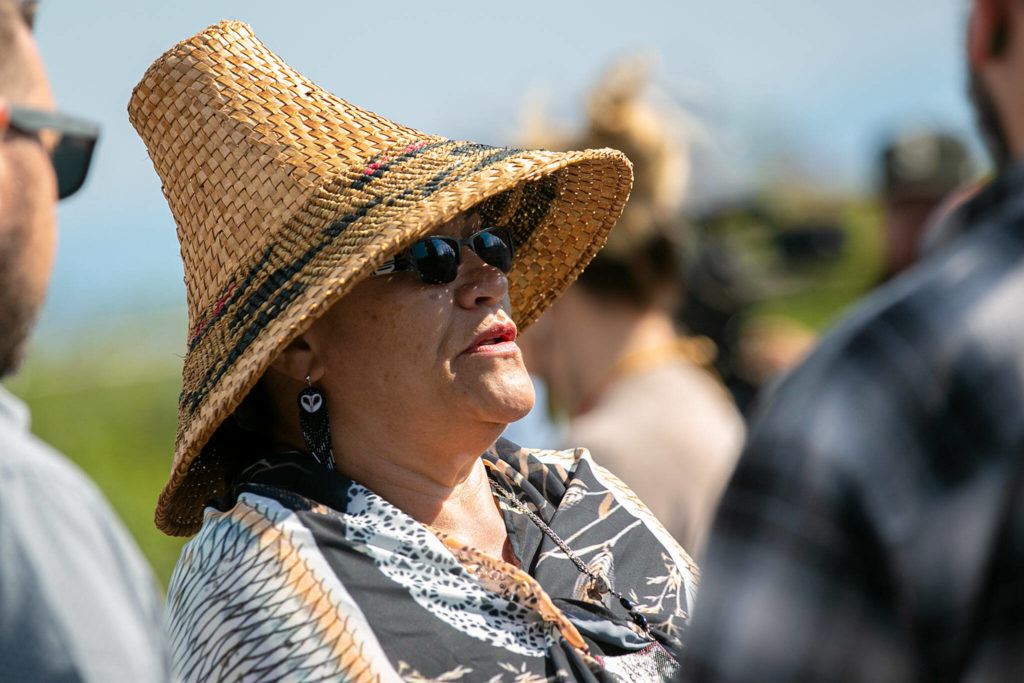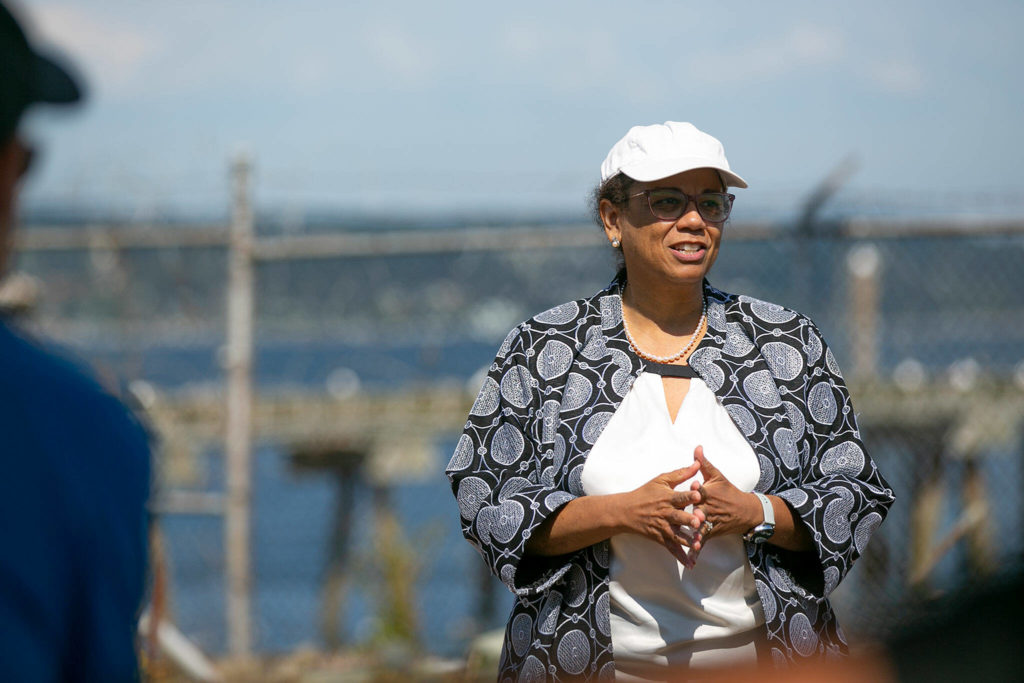MUKILTEO — Jason Gobin remembers scrubbing fish tanks as a high school intern at the Mukilteo research center on the shore of Possession Sound.
Gobin, the Tulalip fisheries director, sang and drummed alongside other leaders from the Tulalip, Swinomish and Suquamish tribes Monday. It was a send off for the federal National Oceanic and Atmospheric Administration research site of over 40 years, where gray paint is flaking off, some windows are broken and there are black stains where a fire burned through the center last year.
The buildings will be demolished in the coming weeks. Songs passed down from cultural stewards like Harriette Shelton Dover echoed off the exterior walls.
For years the eyesore was home to studies on the effects of ocean acidification and other pollutants on marine life. Saltwater tanks housed Dungeness crab, lingcod, geoduck, juvenile salmon and other species threatened by humans’ actions.
Long before the research facility stood on the shore, Coast Salish tribes were caretakers of the sound.
Archaeological studies revealed the Sduhubš, or Snohomish, people maintained a village on the shore of what’s now Mukilteo for at least 4,000 years, said Ryan Miller, director of government affairs and treaty rights for the Tulalip Tribes.
The spot “has huge importance to us,” Miller said, “from a cultural standpoint, from a subsistence standpoint. This was a summer camp that families came to fish, to gather shellfish and to meet with other tribes.”
Teri Gobin, chair of the Tulalip Tribes, gripped a tan drum as she spoke to NOAA officials and tribal leaders Monday. An image of her father Stan Jones Sr. was etched on the front. Jones was one of many Coast Salish leaders who have fought for years to preserve the environment and tribes’ traditional ways.
“It’s a fight that’s been going on since the first people came here,” Teri Gobin said.
Now state and federal agencies, like NOAA, co-manage fisheries with tribes.
Lately, the Tulalip Tribes’ fisheries office has been slammed, Jason Gobin said. A big piece of salmon recovery is navigating the bureaucracy and getting cities, counties, state and federal agencies on the same page. Meanwhile, Puget Sound steelhead and Chinook salmon are in crisis.
“We’re counting on you guys to help honor our treaty,” Leonard Forsman, chair of the Suquamish Tribe, told NOAA officials Monday.
In 1855, ancestors of tribal leaders signed the Treaty of Point Elliott on the same shoreline. It afforded tribes “the right of taking fish at usual and accustomed grounds and stations,” as well as hunting rights and other guarantees.
Mukilteo, known in Lushootseed as bəqɬtiyuʔ, was historically seen as a central meeting place for tribes who used the waterways as highways on canoe.
The closing of the Mukilteo research center is a big loss for nearby tribes, Miller said.
“Our research boat can fly from the Tulalip Marina to here,” Miller said. “A quick 30 minutes, and Seattle is a lot further away. So it’s really a big loss from the research side of it.”
Kevin Werner, research director at the Northwest Fisheries Science Center, said the same research continues in the agency’s Montlake Laboratory in Seattle and the Manchester Research Station in Port Orchard.
The Mukilteo research hub was initially slated to be rebuilt at the 1.1-acre property on Front Street, but those plans were scrapped amid rising construction costs.
Renderings produced by Rolluda Architects showed a modern oblong building parallel to the water. The design featured floor-to-ceiling windows and a boat ramp. The research center would have included public access and was initially targeted to open in 2022, as part of the Mukilteo waterfront master plan.
Congress appropriated $4.5 million for the design and initial site work in 2017, and an additional $35.5 million for the completion of the project in 2019.
Bids reportedly came in over $40 million. Officials did not share how many bids there were or for how much. A spokesperson for NOAA said this week the agency had no “further details to share.”
Originally the building was built as a temporary Air Force barracks during World War II. NOAA began using it for research in the 1970s and took it over in the 2000s.
Now, it’s in the hands of the Port of Everett.
In the coming weeks, the site will be cleared and ready to hand over to the port, said Port CEO Lisa Lefeber. But “the transfer timeline is unknown,” she said.
Lefeber has said the port would like to see the space used in a way “that honors the marine sea life, which is in line with the previous land use.”
Isabella Breda: 425-339-3192; isabella.breda@heraldnet.com; Twitter: @BredaIsabella.
Talk to us
> Give us your news tips.
> Send us a letter to the editor.
> More Herald contact information.




























